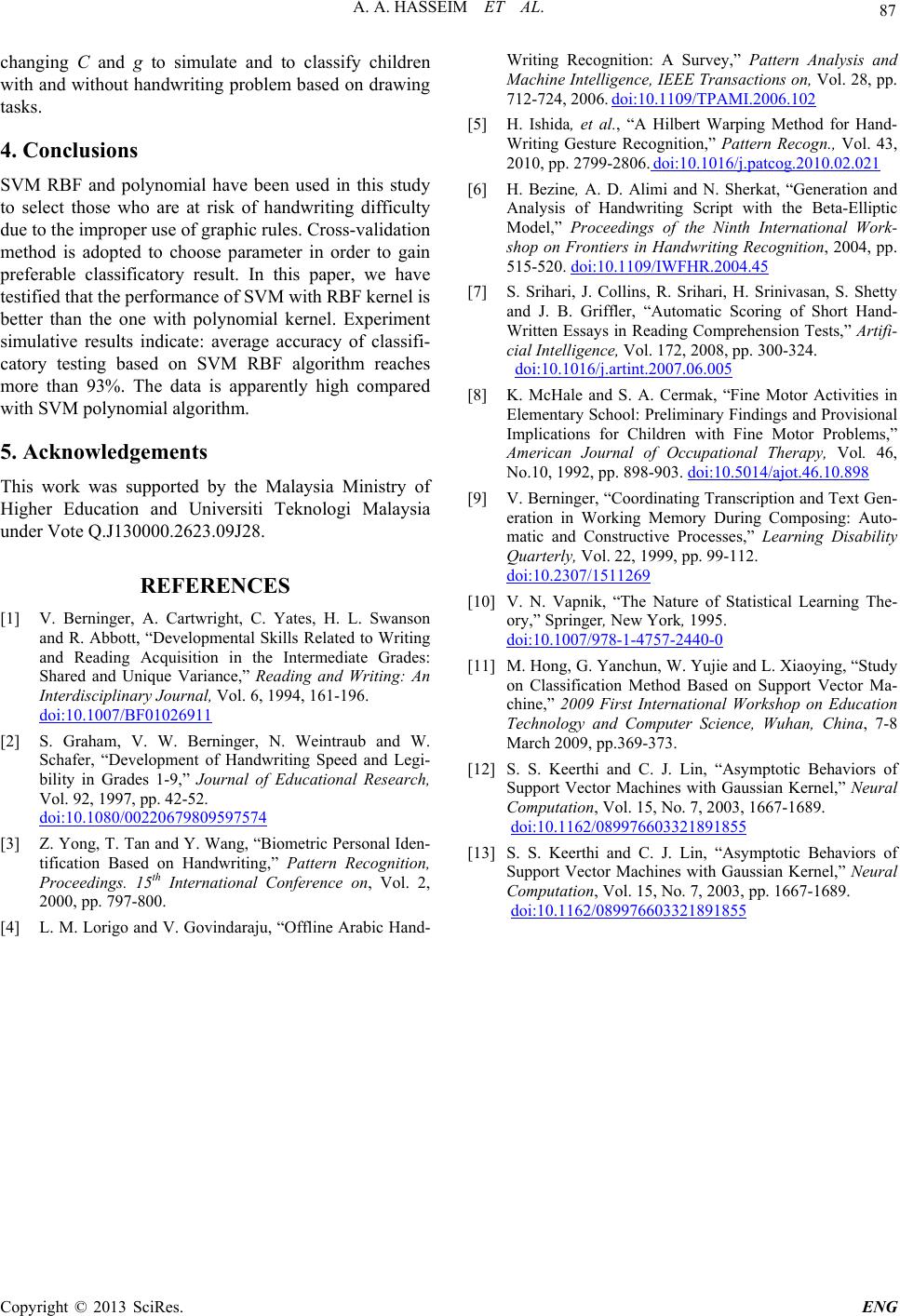
A. A. HASSEIM ET AL. 87
changing C and g to simulate and to classify children
with and without handwriting problem based on drawing
tasks.
4. Conclusions
SVM RBF and polynomial have been used in this study
to select those who are at risk of handwriting difficulty
due to the improper use of graphic rules. Cross-validation
method is adopted to choose parameter in order to gain
preferable classificatory result. In this paper, we have
testified that the performance of SVM with RBF kernel is
better than the one with polynomial kernel. Experiment
simulative results indicate: average accuracy of classifi-
catory testing based on SVM RBF algorithm reaches
more than 93%. The data is apparently high compared
with SVM polynomial algorithm.
5. Acknowledgements
This work was supported by the Malaysia Ministry of
Higher Education and Universiti Teknologi Malaysia
under Vote Q.J130000.2623.09J28.
REFERENCES
[1] V. Berninger, A. Cartwright, C. Yates, H. L. Swanson
and R. Abbott, “Developmental Skills Related to Writing
and Reading Acquisition in the Intermediate Grades:
Shared and Unique Variance,” Reading and Writing: An
Interdisciplinary Journal, Vol. 6, 1994, 161-196.
doi:10.1007/BF01026911
[2] S. Graham, V. W. Berninger, N. Weintraub and W.
Schafer, “Development of Handwriting Speed and Legi-
bility in Grades 1-9,” Journal of Educational Research,
Vol. 92, 1997, pp. 42-52.
doi:10.1080/00220679809597574
[3] Z. Yong, T. Tan and Y. Wang, “Biometric Personal Iden-
tification Based on Handwriting,” Pattern Recognition,
Proceedings. 15th International Conference on, Vol. 2,
2000, pp. 797-800.
[4] L. M. Lorigo and V. Govindaraju, “Offline Arabic Hand-
Writing Recognition: A Survey,” Pattern Analysis and
Machine Intelligence, IEEE Transactions on, Vol. 28, pp.
712-724, 2006. doi:10.1109/TPAMI.2006.102
[5] H. Ishida, et al., “A Hilbert Warping Method for Hand-
Writing Gesture Recognition,” Pattern Recogn., Vol. 43,
2010, pp. 2799-2806. doi:10.1016/j.patcog.2010.02.021
[6] H. Bezine, A. D. Alimi and N. Sherkat, “Generation and
Analysis of Handwriting Script with the Beta-Elliptic
Model,” Proceedings of the Ninth International Work-
shop on Frontiers in Handwriting Recognition, 2004, pp.
515-520. doi:10.1109/IWFHR.2004.45
[7] S. Srihari, J. Collins, R. Srihari, H. Srinivasan, S. Shetty
and J. B. Griffler, “Automatic Scoring of Short Hand-
Written Essays in Reading Comprehension Tests,” Artifi-
cial Intelligence, Vol. 172, 2008, pp. 300-324.
doi:10.1016/j.artint.2007.06.005
[8] K. McHale and S. A. Cermak, “Fine Motor Activities in
Elementary School: Preliminary Findings and Provisional
Implications for Children with Fine Motor Problems,”
American Journal of Occupational Therapy, Vol. 46,
No.10, 1992, pp. 898-903. doi:10.5014/ajot.46.10.898
[9] V. Berninger, “Coordinating Transcription and Text Gen-
eration in Working Memory During Composing: Auto-
matic and Constructive Processes,” Learning Disability
Quarterly, Vol. 22, 1999, pp. 99-112.
doi:10.2307/1511269
[10] V. N. Vapnik, “The Nature of Statistical Learning The-
ory,” Springer, New York, 1995.
doi:10.1007/978-1-4757-2440-0
[11] M. Hong, G. Yanchun, W. Yujie and L. Xiaoying, “Study
on Classification Method Based on Support Vector Ma-
chine,” 2009 First International Workshop on Education
Technology and Computer Science, Wuhan, China, 7-8
March 2009, pp.369-373.
[12] S. S. Keerthi and C. J. Lin, “Asymptotic Behaviors of
Support Vector Machines with Gaussian Kernel,” Neural
Computation, Vol. 15, No. 7, 2003, 1667-1689.
doi:10.1162/089976603321891855
[13] S. S. Keerthi and C. J. Lin, “Asymptotic Behaviors of
Support Vector Machines with Gaussian Kernel,” Neural
Computation, Vol. 15, No. 7, 2003, pp. 1667-1689.
doi:10.1162/089976603321891855
Copyright © 2013 SciRes. ENG